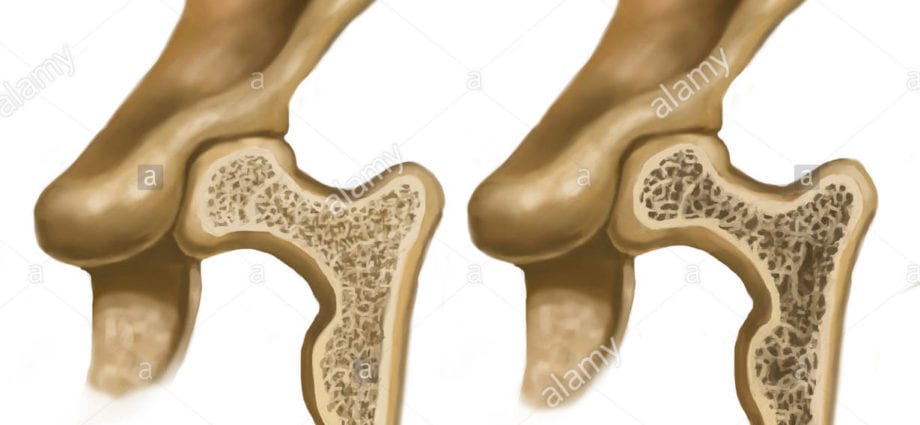Contents
General description of the disease
Osteochondropathy is a disease in which a necrotic deformation process occurs in the cancellous bones. Basically, the disease begins its course in childhood and adolescence.
The causes of the disease:
- 1 genetic factor;
- 2 pathological functioning of the glands of the endocrine system;
- 3 impaired metabolism of nutrients in the body (in particular, poor metabolism of vitamins and calcium);
- 4 frequent injury;
- 5 various circulatory disorders;
- 6 overworking sports, due to which the muscles contract vigorously;
- 7 being overweight;
- 8 diet abuse;
- 9 exclusion from the diet, the consumption of any healthy foods (especially those containing calcium).
Types of osteochondropathy
In traumatology, osteochondropathy is divided into 4 types:
- long tubular bones (the sternum end of the clavicle, the hip joint, the tibia, the phalanges of the fingers, the heads of the 2nd and 3rd metatarsal bones are affected);
- short spongy bones (this group includes the vertebrae, the lunate bone of the hand, the sesamoid bone of the 1st metatarsophalangeal joint, the scaphoid bone of the foot);
- epiphyses (epiphyseal discs of the vertebra, tuberosity of the tibia and tubercle of the calcaneus are affected);
- partial osteochondropathy (this group includes damaged articular surfaces of the elbow, knee and other joints).
The course of osteochondropathy
The disease occurs in 4 phases. The full cycle of osteochondropathy can last from 2 to 4 years.
At the first stage the bone tissue begins to die off. Duration – several months. During this period, the patient begins to feel pain at the site of the lesion, there are disturbances in the functioning of the leg or arm (depending on the site of the lesion). At the same time, the lymph nodes are enlarged. When you touch the sore spot, there is a strong, sharp pain. X-rays may not show any changes.
In the second stage a compression fracture occurs. The bone has sagged and damages the bone beams, simply wedging into them. X-ray shows the affected parts of the bone, the clear outline and structure of the picture disappears. If the pineal gland is affected, then the joint space becomes widened. This period lasts from 3 months to six months.
The third phase – fragmentation. It lasts from six months to three years. At this time, the dead skin areas dissolve, being replaced by osteoclasts and granulation tissue. The bone height decreases.
Recovery takes place on fourth stage the course of the disease. This process can take from a couple of months to several years. The first step is to restore the shape of the bone, and then its structure is renewed.
Complications
If the disease is not treated in any way, then after recovery, the bone will be deformed. This can further lead to the development of another serious disease – deforming arthrosis.
Basically, the disease affects the growing body in adolescence, less often young children and babies, even less often young people.
Useful products for osteochondropathy
During the period when the body develops and grows, it is imperative that it be supplied in sufficient quantities with all useful vitamins, minerals and trace elements. During this period, the supply of vitamins A, B, D, C, collagen, chondroprotectors, magnesium, phosphorus, calcium is vitally important to the bones. Useful:
- products of animal origin: dairy products, rabbit, chicken, beef, offal, jellied meat, jelly, eggs, fish (especially seafood), seafood;
- vegetable products: sorrel, cucumbers with tomatoes, spinach leaves, lettuce, radishes, beets, carrots, all types of cabbage, celery, blue, zucchini, pumpkin, artichokes, sea buckthorn berries, rose hips, legumes and cereals, cereals, corn, melon , seeds and nuts, raisins and dried apricots, bananas, olives, peaches, nettles, sesame seeds, avocados;
- drinks: mineral non-carbonated waters, green tea, jelly, freshly squeezed juices from the above-mentioned berries, fruits and vegetables;
- sweets and bakery products: jelly, not sweet and not rich biscuits, biscuit, gray, rye whole grain bread, bread with grain and bran.
All meals should be boiled or steamed or in a slow cooker.
Traditional medicine for osteochondropathy
In case of osteochondropathy, the diseased limb must be kept in a gentle mode and fixed in the tire. The patient can even be assigned to bed rest. Any loads are contraindicated. Prescribed hydrogen sulfide and radon baths, therapeutic massage, sollux, paraffin heating. The treatment does not provide for any physiotherapy exercises and gymnastics.
It is allowed to make warming compresses from horseradish root, garlic tincture, refined turpentine and mustard powder diluted in warm water.
Dangerous and harmful products for osteochondropathy
- fatty, rich broths;
- dried fish and smoked meats;
- too salty, fatty, fried food;
- pastry cream and pastry;
- products and drugs with caffeine, artificial additives;
- spicy food;
- store sauces, mayonnaises, spices, marinades.
Attention!
The administration is not responsible for any attempt to use the information provided, and does not guarantee that it will not harm you personally. The materials cannot be used to prescribe treatment and make a diagnosis. Always consult your specialist doctor!










